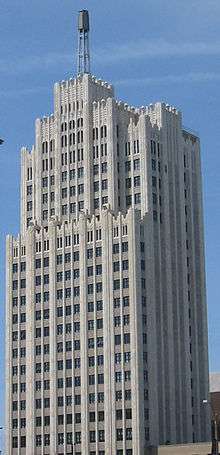Continental Life Building
| Continental Life Building | |
|---|---|
 | |
| General information | |
| Status | Complete |
| Type | Apartments |
| Location | 3615 Olive St., St. Louis, Missouri |
| Coordinates | 38°38′19″N 90°13′58″W / 38.6385°N 90.2327°WCoordinates: 38°38′19″N 90°13′58″W / 38.6385°N 90.2327°W |
| Completed | 1930 |
| Owner | Owen Development |
| Height | |
| Roof | 286 feet (87 m) [1] |
| Technical details | |
| Floor count | 22 |
| Lifts/elevators | 2 |
| Design and construction | |
| Architect | William B. Ittner |
The Continental-Life Building, also known as the Continental Building, is an Art Deco skyscraper in St. Louis, Missouri, USA, which was completed in 1930. The building is located in Grand Center in St. Louis' Midtown neighborhood, and it is visible from Interstate 64/Highway 40 and Interstate 44.
Commissioned by Edward Mays to be the home of his two businesses, Continental-Life Insurance and the Grand National Bank, the building was designed by William B. Ittner, a prominent St. Louis architect.
On September 22, 1955, the building was purchased for $2 million by then 27-year-old developers Robert A. Futterman and Jerry Tenney. When Futterman died suddenly in 1961, choking on a sandwich at a dinner party at age 33, his death propelled the building into near insolvency.[2] In his 2003 book The Queen of Lace, The Story of the Continental Life Building, developer and author Stephen Trampe called it "the sandwich that started the decline."[2]
The tower housed businesses through the mid-1960s when its co-owners included St. Louis mayor Alfonso J. Cervantes, prominent St. Louis defense attorney Morris Shenker, and Harold Koplar of KPLR. At some point in the 1970s the building fell into disrepair.
After a few false starts in the late 1990s, St. Louis developers Stephen Trampe and Mike Barry took on the project, renovating the building into apartments. It reopened in 2001. Trampe later wrote a book about the building's history and rebirth.[2]
The building has a connected three-story parking garage, which is used by both residents and patrons of the nearby Fox Theatre. The top of the parking garage holds an outdoor pool for residents' use.
A notable number of St. Louis landmarks are visible from the building because of its location and height. Some of these include the Gateway Arch, One Metropolitan Square (St. Louis' tallest building), the Edward Jones Dome, the City Museum, the Civil Courts Building, the Anheuser Busch brewery, portions of the Missouri Botanical Garden including the Climatron geodesic dome, the St. Louis State Hospital, the Compton Hill water tower, the campus of St. Louis University and the St. Louis Science Center.
Architectural elements from the building were collected over time by the St. Louis Building Arts Foundation and returned to the building in the Stephen Trampe renovation. Other elements still reside at the foundation's Sauget, Illinois storage site.
References
- ↑ Emporis.com - Retrieved May 25, 2008
- 1 2 3 The Queen of Lace, The Story of the Continental Life Building, The Sandwich that Started the Decline, p. 167. Stephen L. Trampe, 2003, Virginia Publishing Company.
In November 1961, Robert Futterman choked on a roast beef sandwich at a dinner party and died.6 His tragic death was the first of several voids in leadership that would contribute to the building's decline. This void and lack of leadership affected not only the debt service payments to the lender, New York Life, but it stopped all marketing and leasing work that was required to keep a fading superstar building from falling into bankruptcy.